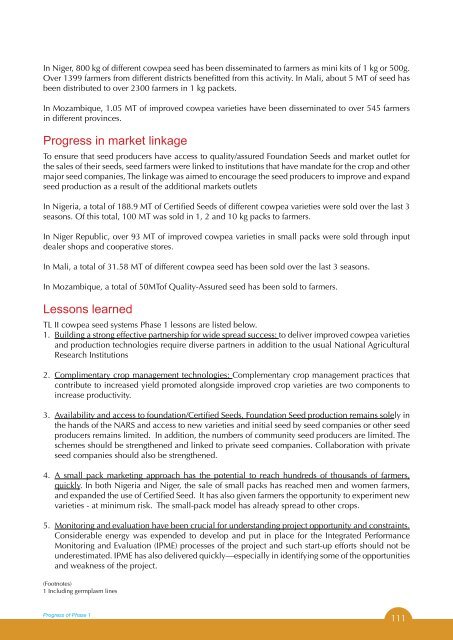Four Seasons of Learning and Engaging Smallholder Farmers - icrisat
Four Seasons of Learning and Engaging Smallholder Farmers - icrisat
Four Seasons of Learning and Engaging Smallholder Farmers - icrisat
You also want an ePaper? Increase the reach of your titles
YUMPU automatically turns print PDFs into web optimized ePapers that Google loves.
In Niger, 800 kg <strong>of</strong> different cowpea seed has been disseminated to farmers as mini kits <strong>of</strong> 1 kg or 500g.<br />
Over 1399 farmers from different districts benefitted from this activity. In Mali, about 5 MT <strong>of</strong> seed has<br />
been distributed to over 2300 farmers in 1 kg packets.<br />
In Mozambique, 1.05 MT <strong>of</strong> improved cowpea varieties have been disseminated to over 545 farmers<br />
in different provinces.<br />
Progress in market linkage<br />
To ensure that seed producers have access to quality/assured Foundation Seeds <strong>and</strong> market outlet for<br />
the sales <strong>of</strong> their seeds, seed farmers were linked to institutions that have m<strong>and</strong>ate for the crop <strong>and</strong> other<br />
major seed companies, The linkage was aimed to encourage the seed producers to improve <strong>and</strong> exp<strong>and</strong><br />
seed production as a result <strong>of</strong> the additional markets outlets<br />
In Nigeria, a total <strong>of</strong> 188.9 MT <strong>of</strong> Certified Seeds <strong>of</strong> different cowpea varieties were sold over the last 3<br />
seasons. Of this total, 100 MT was sold in 1, 2 <strong>and</strong> 10 kg packs to farmers.<br />
In Niger Republic, over 93 MT <strong>of</strong> improved cowpea varieties in small packs were sold through input<br />
dealer shops <strong>and</strong> cooperative stores.<br />
In Mali, a total <strong>of</strong> 31.58 MT <strong>of</strong> different cowpea seed has been sold over the last 3 seasons.<br />
In Mozambique, a total <strong>of</strong> 50MT<strong>of</strong> Quality-Assured seed has been sold to farmers.<br />
Lessons learned<br />
TL II cowpea seed systems Phase 1 lessons are listed below.<br />
1. Building a strong effective partnership for wide spread success: to deliver improved cowpea varieties<br />
<strong>and</strong> production technologies require diverse partners in addition to the usual National Agricultural<br />
Research Institutions<br />
2. Complimentary crop management technologies: Complementary crop management practices that<br />
contribute to increased yield promoted alongside improved crop varieties are two components to<br />
increase productivity.<br />
3. Availability <strong>and</strong> access to foundation/Certified Seeds, Foundation Seed production remains solely in<br />
the h<strong>and</strong>s <strong>of</strong> the NARS <strong>and</strong> access to new varieties <strong>and</strong> initial seed by seed companies or other seed<br />
producers remains limited. In addition, the numbers <strong>of</strong> community seed producers are limited. The<br />
schemes should be strengthened <strong>and</strong> linked to private seed companies. Collaboration with private<br />
seed companies should also be strengthened.<br />
4. A small pack marketing approach has the potential to reach hundreds <strong>of</strong> thous<strong>and</strong>s <strong>of</strong> farmers,<br />
quickly. In both Nigeria <strong>and</strong> Niger, the sale <strong>of</strong> small packs has reached men <strong>and</strong> women farmers,<br />
<strong>and</strong> exp<strong>and</strong>ed the use <strong>of</strong> Certified Seed. It has also given farmers the opportunity to experiment new<br />
varieties - at minimum risk. The small-pack model has already spread to other crops.<br />
5. Monitoring <strong>and</strong> evaluation have been crucial for underst<strong>and</strong>ing project opportunity <strong>and</strong> constraints.<br />
Considerable energy was expended to develop <strong>and</strong> put in place for the Integrated Performance<br />
Monitoring <strong>and</strong> Evaluation (IPME) processes <strong>of</strong> the project <strong>and</strong> such start-up efforts should not be<br />
underestimated. IPME has also delivered quickly—especially in identifying some <strong>of</strong> the opportunities<br />
<strong>and</strong> weakness <strong>of</strong> the project.<br />
(Footnotes)<br />
1 Including germplasm lines<br />
Progress <strong>of</strong> Phase 1<br />
111

















